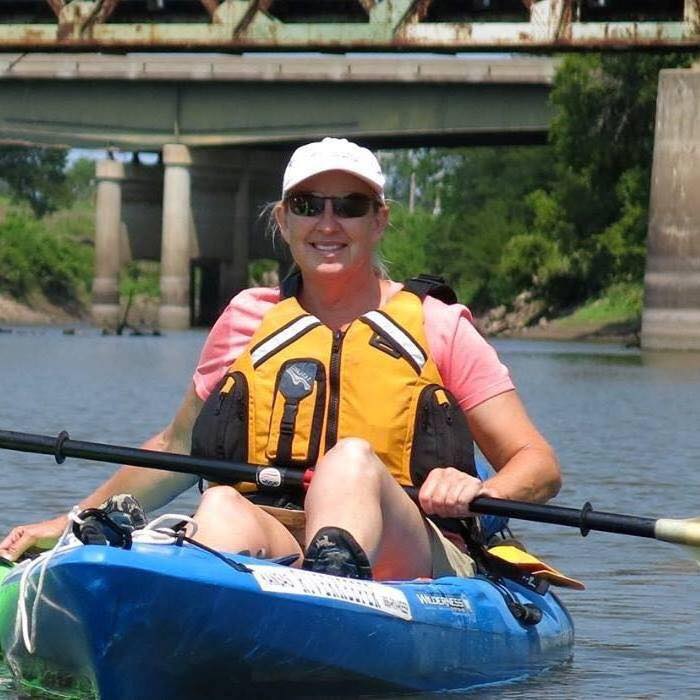Now that we have calculated our water footprint and the amount of stormwater coming off our roofs and learned about our watersheds and connections to the Kaw, its time to figure out what we can do in our everyday lives to help the river and all the people, plants and animals that depend on it.
Reduce Your Water Footprint
- What are the things that you do that use the most water?
- How much water do you use for these activities?
- How can you reduce the amount of water that you use?
- How can you reduce the amount of chemicals that you put in the water that goes down your drain?
- Click Here for simple ways to save water.
Why Reduce Your Water Footprint?
- By reducing your Water Footprint you will reduce the amount of water that must be taken out of the river.
- You will reduce the amount of water that goes into sewage treatment plants– water from sewage treatment plants goes back to the river and can add pollution to the river.
- And you will reduce the amount of electricity that it takes to move the water from the river to your house and from your house back to the river (including electricity used by the water treatment plant that cleans the water before it goes to your house and the sewage treatment plant that cleans the water leaving your house).
Reduce Pollution From Stormwater Runoff
- How much water runs off your roof in during a 1 inch rainstorm?
- How can you reduce the amount of water that runs off your house and down street drains to the river?
Here are a few suggestions:
- Connect your downspouts to rain barrels.
- Plant a rain garden.
- Reduce the amount of yard chemicals you use (like pesticides and fertilizers).
- Don’t let your car leak oil on your driveway.
- Get rid of old chemicals used in your house and in your yard at household hazardous waste collection centers.
- Clean up after your pet.
- Use a commercial car wash (they clean and recycle their water). Or you can wash your car on a lawn so that it can soak up the water before it goes to storm drains.
- Sweep up leaves rather than washing them down the storm drain with a hose. Compost or recycle yard waste.
- Clean paint brushes in a sink. That way the water will go to the sewage treatment plant and get cleaned before it goes to the river. If you clean paint brushes outside the water will go down storm drains and into the river without being cleaned up by a sewage treatment plant.
Why Reduce Pollution From Stormwater Runoff?
- Water that runs off your house, lawn and driveway goes into storm drains in the street and then either directly to streams and rivers (with no water treatment at all) or to Combined Sewer Overflows (which can cause sewage to be dumped into the river).
- Reducing the amount of rain water that runs off your house and yard reduces the amount of Nonpoint Source Pollution that enters the river. Nonpoint Source Pollution from stormwater runoff is one of the biggest types of pollution that harms the Kansas River.
Be Kind To Your Watershed
Now that you know that “water runs downhill” you know that everything in a watershed washes down to the lowest point. That means that what we put on the ground can be washed into the river during a rainstorm.
You also know that your watershed is where you get your water from, where your waste water goes, where your electricity is produced– all kinds of things that are really important to you come from your watershed.
We All Live In A Watershed!
Everything we do on the land and in the water within a watershed has the potential of washing into the river. For example, did you know that the most common type of litter that we find in the Kansas River is plastic bags and plastic bottles that wash down storm drains? Yes, even littering is bad for the river!
Educate Others About Their Connection To The Kaw
You can use all the things that you have learned in Caring for the Kaw to educate others about how to be Good Watershed Citizens!
Take the time to show others the maps and action plans that you made. Let them know that we all have to work together to make sure that the river– and all of the things that depend on it (like us!)– is healthy and safe for everybody (the frogs, turtles, birds, fish, bugs…).
Ready to get started? Use the Action Plan below! Click on the link below the image to download a Word document that you can edit.
[gview file=”https://kansasriver.org/wp-content/uploads/2016/03/ActionPlanNotebook.docx”]

 Paddle safely! Use the links below to quickly access information that impacts river conditions.
Paddle safely! Use the links below to quickly access information that impacts river conditions.
